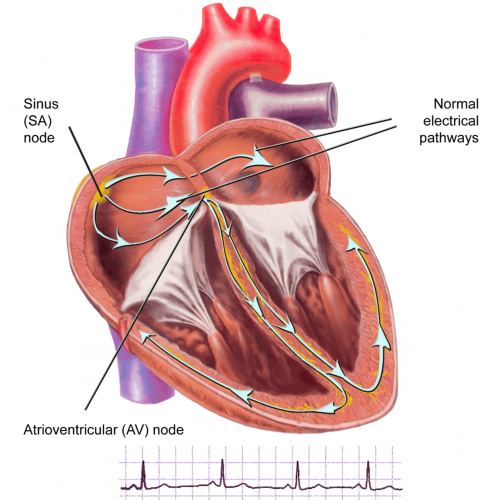Other Arrhythmias
For the heart to beat effectively the heart muscle cells must contract in an organised and predetermined way. The heart has its own electrical wiring system, which transmits an electrical pulse along predefined pathways, causing timely contraction of the upper chambers, the atria, which squeeze blood into the lower chambers, the ventricles. These then contract, ejecting blood through the main arteries to the body and lungs. The electrical impulse originates in the heart’s own pacemaker, the sinoatrial (SA) node. This emits an electrical pulse at a rate determined by the body’s requirements; the pulse slows whilst sleeping, but increases with exercise, fever and emotional stress, for example.

Abnormalities in heart rhythm can cause a change in heart rate, either making it faster or slower, and rhythm, which may or may not cause symptoms. Symptoms vary depending on the type of arrhythmia and include breathlessness, fatigue, palpitations, dizzy spells and blackouts. There are many different types of heart irregularity, each with its own mechanism, and the treatment required will be specific to the precise heart rhythm causing the problem. In general terms, very slow heart rates may need treatment with a pacemaker; fast rhythms may need treatment with anti-arrhythmic drugs (chemical cardioversion), electrical cardioversion or ablation, and some patients need the protection of an implantable defibrillator-cardioverter (ICD).

Related links:
Symptoms - Palpitations, dizzy spells and
blackouts
Palpitations are a common symptom that may or may not signify an important underlying heart problem. Read more
Tests - ECG Monitoring
There are several different types of ECG monitoring, chosen based on symptoms or the condition in question. Read more
Tests - EP Study
There are many types of abnormal heart rhythm, some minor, some troublesome and some posing a risk to life. Read more
Treatments - Ablation
The role of ablation in the treatment of various abnormal heart rhythms has evolved over the last two decades and now has an established place in the management of various arrhythmias. Read more
Treatments - Pacemaker
The first pacemakers were developed in the 1930s and the first use in man was in the 1950s. Back then they were bulky, crude and very limited in function. Read more